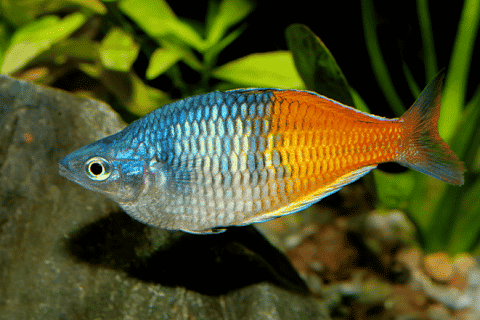Thank you for visiting! By the way… any links on this page that lead to products on Amazon and other stores/partners are affiliate links Aquarium Store Depot earns a commission if you make a purchase.
Tired of seeing the same fish in every tank? Rainbowfish may already be popular additions to the freshwater aquarium, but we think they deserve more attention. These fish are easy to keep, colorful, and active. They can happily live with various community fish species and shine in a planted tank setup.
Key Takeaways
- Boesemani rainbowfish are colorful fish that can grow to be slightly larger than other freshwater community species.
- These fish don’t have any special requirements, but they do best in heavily planted setups.
- Boesemanis can sometimes outcompete other species for food, so tank mates need to be carefully chosen or a specific feeding method needs to be used.
- These rainbows can be bred in the home aquarium, which lessens the impact on dwindling natural populations.
Overview Of The Fish Species
| Scientific Name | Melanotaenia boesemani |
| Common Names | Boesemani Rainbowfish, Boeseman’s Rainbowfish |
| Family | Melanotaeniidae |
| Origin | Indonesia |
| Diet | Omnivore |
| Care Level | Moderate |
| Activity | Moderate activity |
| Lifespan | 5 to 10 years |
| Temperament | Peaceful |
| Tank Level | Middle |
| Minimum Tank Size | 40 gallons |
| Temperature Range | 72 – 77° F |
| Water Hardness | 9 – 19 KH |
| pH Range | 7.0 – 8.0 |
| Filtration/Water Flow | Low to moderate |
| Water Type | Freshwater |
| Breeding | Egg Layer |
| Difficulty to Breed | Moderate |
| Compatibility | Community tanks |
| OK, for Planted Tanks? | Yes |
Introduction To Boesemani Rainbowfish
Everybody has tetras in their tank. We don’t blame them. Tetras are small yet colorful fish that can make any tank come to life.
But isn’t there another, more unique alternative that’s just as colorful and exciting?
Yes! Past the tetras and the rasboras, there’s a wide variety of rainbowfish species available for beginner to expert hobbyists. These fish have all the characteristics that make tetras desirable but offer a new shape and personality to the community fish tank. The Boesemani rainbowfish, scientifically known as Melanotaenia boesemani, is one of the most popular species of rainbowfish available in the aquarium hobby.
Though these fish are very popular in the hobby and have been successfully bred commercially, they are, unfortunately, endangered in their wild natural habitat ecosystems and listed on the IUCN Red List of endangered species. This is a direct result of harvesting done by the aquarium hobby, so it is strongly encouraged to ethically source the next rainbowfish that you add to your tank.
Otherwise, rainbowfish are large, active schooling fish that can be kept in moderately sized aquariums. They get along with most freshwater community fish species and are hardy to most aquarium water parameters.
Origin and Habitat
The Boesemani rainbowfish is one of the most colorful species of fish that occurs naturally in the wild. These blue and orange fish have a very limited natural range, with populations existing only in the tri-lake region of Indonesia known as Ajamaru. Some other populations have been found in nearby lakes, namely Lake Hain and Lake Aitinjo.
There, Boesemani rainbowfish stay in the shallow waters. They can be found in dense vegetation where they school and reproduce. Though the waters from these lakes are naturally hard with high pH, Boesemani rainbowfish have been found in various hardness and pH conditions. This has made acclimating them to the water parameters preferred by aquarium fish that much easier.
As we’ll see, these fish do best in heavily planted aquariums with low to moderate water flow.
Appearance
Rainbowfish have unique appearances that make them attractive to hobbyists who want something a little different from your typical tropical fish. There are many different species of rainbowfish available, with some staying small and others growing large with special features.

The true appeal of this rainbowfish is its colors. There is no other fish that compares! The Boesemani rainbowfish is brightly colored with blues, yellows, oranges, and even greens. Male Boesemani rainbows feature the greatest contrast in colors, with the first half of their body being a dark blue that slowly fades into a deep orange by their tail fin. In contrast, females are solid silver or yellowish-green with lighter-colored bellies.
The Boesemani rainbow also has an interesting body shape. They have a deeper body with long dorsal and anal fins. Female fish aren’t as deep-bodied, but can still easily be told apart from other species.
How Big Do They Get?
The Boesemani rainbowfish is a moderately sized species of rainbow. Male fish grow to be slightly larger than females, maxing out at about 5 inches. Females generally stay under 4 inches at adult size.
Boesemani Rainbowfish Care
Boesemani rainbowfish care is relatively easy, though there are some special considerations that should be taken into account before buying them. If given the right aquarium setup, though, these fish can live for relatively long times and will bring new colors to a fish tank.
Are They Easy To Keep?
In general, Boesemani rainbowfish are very easy to keep: they’re hardy fish that have been bred to withstand most conditions seen in the aquarium hobby. However, they are large, active fish that can sometimes be overbearing for other species.
Despite their larger size, they can also be somewhat skittish fish. Because of this, it’s essential to keep them in sizeable groups with an appropriate ratio of female to male fish. This grouping setup will also help increase color expression from the males while also lessening the harassment between males and females.
To help make your fish even more comfortable in its tank, a heavily planted setup is recommended.
Aquarium Setup
Unlike tetras and other popular tropical fish, Boesemani rainbows should be given some special consideration when setting up their tank. These fish shine best when given the right conditions.
An ideal Boesemani aquarium setup would be filled with dense vegetation at all levels of the aquarium. These fish mostly swim in the middle but will gladly venture to the tops and bottoms of the tank to look for food. To help make them more comfortable, add live plant species that grow in the foreground, midground, and background. Otherwise, regularly prune plants to create a layered effect.
Editor's Choice
Manzanita offers it all. Great shape, low tannins, quick to water log and reasonably priced. It's the ultimate driftwood!
Rocks, driftwood, and other natural aquarium decorations may be added to create depth and interest as well as various hiding spots for your fish. Make sure to keep plenty of space open in the middle of the tank as these rainbows like to swim! While unlikely to jump out of the aquarium, it’s recommended to use an aquarium lid that stops any overly adventurous fish.
Tank Size
We list Boesemani rainbowfish as moderately difficult fish to keep due to their relatively demanding tank size. These are larger-than-average tropical fish that need plenty of room to swim and school. That being said, they don’t require a massive setup, either.
Boesemani rainbowfish need a minimum tank size of 40 gallons. Any smaller than this reduces the number of rainbows that can be kept together and the other species that can be added. Any aquarium larger than this greatly increases the possibility of keeping other rainbows and species.
Remember that a lot of aquarium space will be lost to plants and decorations in a heavily planted tank.
Water Parameters
Boesemani rainbows are hardy fish. They’ve been successfully bred in the aquarium industry, meaning they have been comfortably kept in many different water parameters. This also means that they’ve been exposed to many common freshwater diseases, helping their immune systems recognize and overcome pathogens faster and easier.
These rainbowfish do best when kept in tropical water conditions with a constant water temperature between 72 – 77° F. While a tropical species, hobbyists report having greater success keeping their Boesemanis in slightly cooler water temperatures.
As mentioned before, Boesemani rainbowfish have been found in varying pH levels. In general, the aquarium should be kept at neutral pH, between 7.0 – 8.0. Water hardness should remain between 9 – 19 KH, but they are highly adaptable to changing hardness levels as well.
Filtration and Aeration
Boesemani rainbows don’t mean to be messy, but their size, activity, and willingness to eat anything can make for a high bioload. Luckily, plants help uptake nutrients and other wastes to perform food production. This reduces the need for extensive tank maintenance, though some care is still needed.
An adequately sized filter is highly recommended for a Boesemani rainbowfish tank. This filter should be rated for at least 2x the tank size to help remove waste and provide water circulation. These rainbows are strong swimmers and are able to swim against a moderate water flow but need areas of lower flow. Consider the types of live plants you plan on keeping too. Many species prefer gentle water movement.
The Pro's Choice
The top choice among professional aquascapers. German engineering and equipped with an intregrated heater.
Additional aeration is always welcomed and can be achieved through a sponge filter and/or air stone. A large sponge filter or several smaller ones can create low water movement while also facilitating gas exchange, which is important for plant health. An air stone can also be attached to an air pump for aesthetic purposes or for better gas exchange.
Lighting
The type of lighting you need for your tank depends on the types of plants being kept. Boesemani rainbowfish can be skittish with other active species and sudden shadows, but they can typically be kept under higher lighting setups as long as an aquarium lid is secured. In other words, these rainbows won’t avoid swimming out in the open just because of high lighting conditions.
Instead, base the amount of lighting on the species of live plant being kept. Even with high lighting, rainbowfish will use their natural habitat to hide if they feel uncomfortable or stressed; if you do find that your fish is hiding in the shadows, try adding more live plants, floating plants, or structures to increase available areas for relief.
Aquarium Plants and Decorations
Aquarium plants are a must for Boesemani rainbows. These fish originate from very densely planted areas which provide them with food and shelter. It seems counterintuitive, but the more places you have available for your fish to hide, the more likely they’ll be out in the open.
Aquarium plants also make for a healthy tank. In order to perform photosynthesis and grow, plants need nutrients. The fish and invertebrates provide these nutrients in the aquarium. As these excess nutrients are used, the water is cleaned, meaning less work for the hobbyist. This also means that additional fertilization may be necessary if enough nutrients aren’t naturally entering the system.
Editor's Choice
Made by an aquascaper for aquascapers. This is the best all around aquarium plant fertilizer on the market. Marco and micronutrients in one bottle!
Use Coupon Code ASDComplete for 10% off your order!
In addition to plants, rocks, and driftwood, other aquarium-safe decorations may be added to your rainbowfish tank. Make sure that these objects are securely placed, as Boesemanis can bump into them and knock them over when going at high speeds.
Tank Maintenance
Because most rainbowfish are kept in well-planted tanks, tank maintenance is low. In fact, some aquarium keepers leave their Boesemani tanks unfiltered, leaving the live plants and fish to find a balance between nutrient input and output; we only recommend this Walstad method for very experienced hobbyists.
Still, regular weekly or biweekly 10-25% water changes are recommended. Performing water changes helps remove waste caught around the stems of plants while also introducing new, nutrient-rich water for plants to use. If using a pure source of water, like from reverse osmosis, then minerals will need to be manually added back in.
If dosing fertilizers, regularly use a dependable water testing kit to see how nutrients are moving throughout the system.
Substrate
Boesemani rainbowfish can be kept on any substrate. A dark substrate will help complement and intensify their coloration but it isn’t necessary to make these fish bold.
Instead, the substrate should be chosen with plants in mind. For this reason, many hobbyists use plant-specific substrates that facilitate healthy root growth. Another good alternative is aquarium-purpose river sand that comes in various color grades.
Community Tank Mates
For the most part, Boesemani rainbowfish are peaceful fish that can be kept with various species. The main concerns in choosing suitable tank mates for them are matching preferred water temperatures and activity levels.
Can They Go In A Community Tank?
Yes! Boesemani rainbows thrive in a community tank setting. They are often used as the featured species of the tank, with all other fish complimenting their movement and colors.
Some of the best Boesemani rainbowfish tank mates include:
Because these rainbows prefer harder water, some hobbyists have had luck keeping them with some of the more peaceful species of African rift lake cichlids. Avoid smaller, slow-moving fish tank mates that could easily be overwhelmed and outcompeted.
Boesemani rainbowfish are schooling fish that love to be in their own company. However, an imbalance of males to females can lead to harassment, so it’s recommended to keep 2 to 3 females for every male fish. At least 6 rainbowfish should be kept together at any given time.
Can They Live With Angelfish?
Boesemani rainbowfish can live with angelfish under certain conditions. Angelfish are slow-moving fish, but as cichlids, they can defend themselves. This pairing can work if the angelfish are larger than the rainbowfish and more aggressive. Otherwise, the Boesemanis may be too overwhelming and outcompete the angels.
Food and Diet
These rainbows happily accept any and all foods. They are active swimmers that need a lot of food to keep them going. A small portion of high-quality flake food may be given a couple of times throughout the day. This will help keep costs down while also encouraging your fish’s colors while fulfilling their appetite.

For a treat, Boesemani rainbowfish may be given a mixed diet of freeze-dried, live, and frozen foods. They especially love brine shrimp, bloodworms, tubifex worms, and mosquito larvae. As omnivores, they will also eat green vegetables, like spinach and cucumber. While these rainbows aren’t overly messy fish, regular feedings of protein-rich food can lead to water quality issues.
While Boesemani rainbows might seem like they have large mouths, they actually have small throats, which can limit what they eat. Make sure to feed appropriately-sized live foods and cut up any pieces that might seem too big.
Another concern with Boesemani feeding is that they are too ambitious. These are fast fish and even faster eaters. This can cause other fish to miss out and become stressed. To help mitigate this problem, try feeding Boesemanis sinking foods and the other fish floating foods. This should help keep all fish occupied with eating at different levels of the tank.
Breeding Boesemani Rainbows
Breeding Boesemani rainbowfish has been achieved at the commercial level. They are relatively easy to breed in the home aquarium setting though it’s recommended to use a breeding tank. Raising their fry can be somewhat challenging, and a breeding tank will provide the most control over conditions.
To start breeding your Boesemani rainbowfish, place a group of females with one to two males. Feed high-quality food and a steady diet while raising the water temperature to about 80 – 84° F and pH to slightly basic at 7.5. When ready, females will become plump, and males will intensify in color.
As egg scatterers, female Boesemanis will freely release their eggs, and the males will fertilize them. Fine-leaved plants, like Java moss, or egg crate, can be used to catch the eggs. Once the eggs have been fertilized, the adult fish may be removed from the tank to prevent them from eating the eggs.
After about a week, the fry hatch. They will need to be given small foods, like infusoria, until they’re big enough to accept bigger foods, like baby brine shrimp. After a few months, they are ready to be given to another hobbyist or moved back to the display tank.
Conclusion
Boesemani rainbowfish are great fish for hobbyists looking for something new. These fish are just as easy as tetras and rasboras but offer new colors and shapes to add to the community fish tank setup. There are a few considerations needed when picking tank mates, as these rainbows can be overly active and ambitious feeders, but they are not aggressive. They are also relatively easy fish to breed for beginner hobbyists looking for a new challenge!
- About the Author
- Latest Posts
I’m thrilled that you found Aquarium Store Depot! Here you’ll find information on fish, aquariums, and all things aquatics related. I’m a hobbyist (being doing this since I was 11) and here to help other hobbyists thrive with their aquariums! I adhere to a high quality Editorial Process and Review products with real life field usage and practical analysis.








